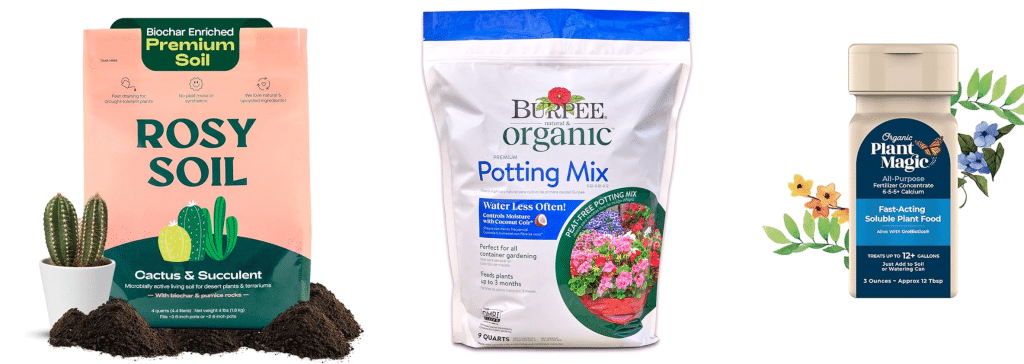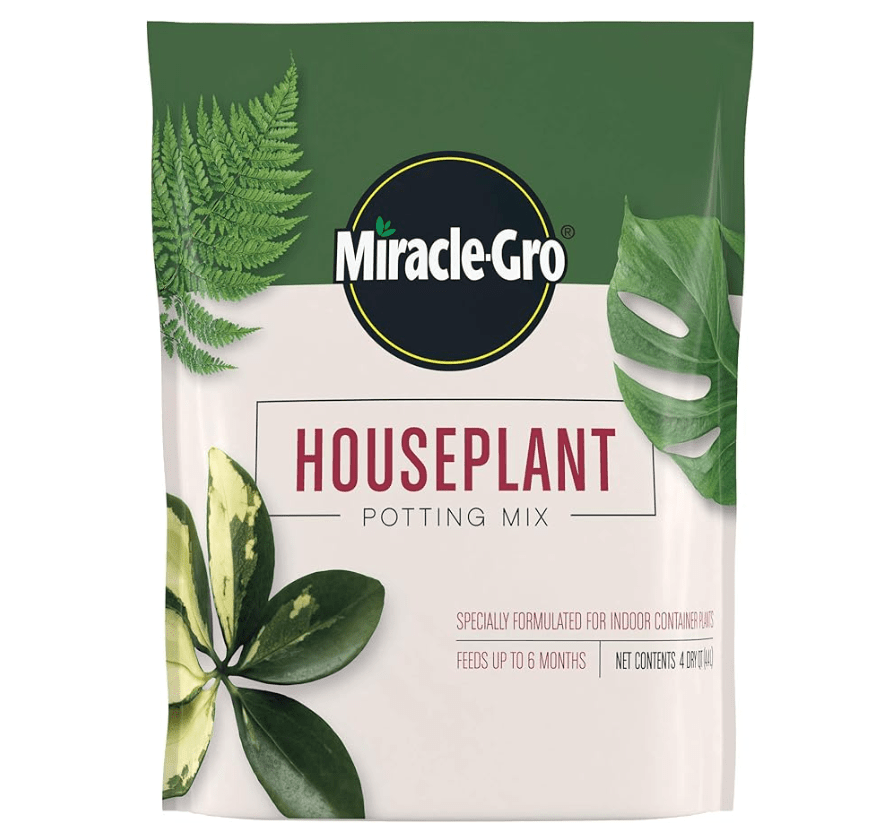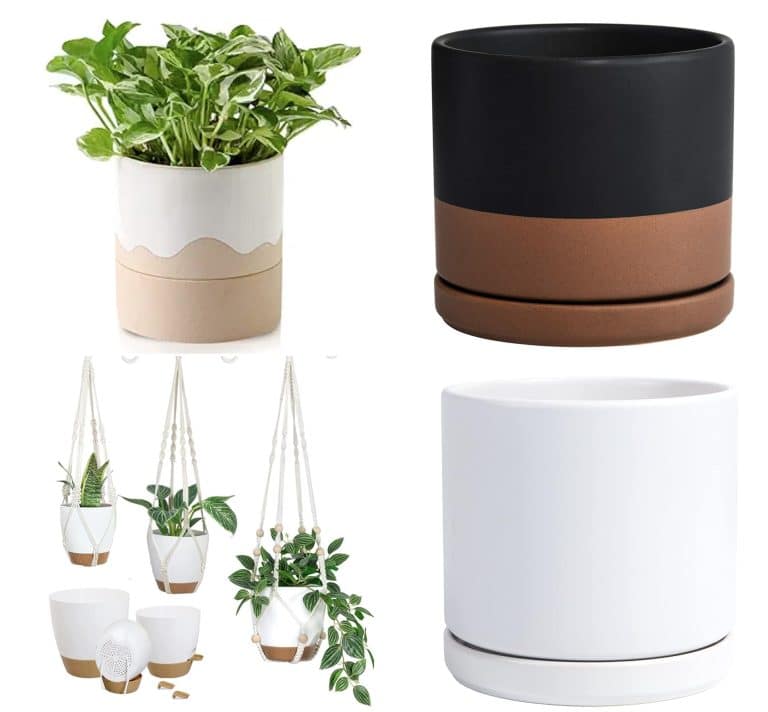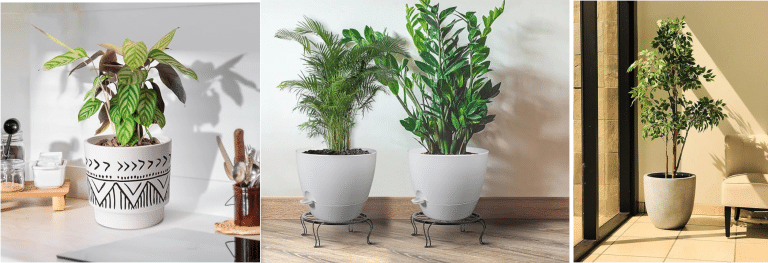The Ultimate Guide to Soil & Fertilizers for trailing indoor plants
Explore our first-hand tested recommendations for soil and fertilizers for the trailing indoor plants grown in our Brooklyn community home!

When you purchase through links here, we earn an affiliate commission, which helps sustain our blog!
Trailing indoor plants bring movement and elegance to our indoor spaces, but if you’ve ever dealt with droopy vines or yellowing leaves, chances are your soil or fertilizer wasn’t quite right. We’ve been there—watching a beautiful pothos suddenly stall out, or a string of hearts shrivel up, even when light and water seemed on point.
The truth is, the best soil and fertilizer for trailing houseplants depends on drainage, aeration, and nutrient balance. Whether you’re hanging a philodendron from the ceiling or styling a shelf with creeping inch plant, this guide breaks down what each plant needs to grow full and lush. From soil mix recipes to the best feeding routines, we’ve got your trailing beauties covered!
Best overall Soil and fertilizer mix for trailing indoor plants
Best Soil Mix

Best fertilizer mix

Categorizing trailing indoor plants by Soil and Fertilizer Needs
Not all trailing indoor plants have the same root structure or watering preferences. We break them down into three categories:
- Succulent Trailers (String of Pearls, String of Bananas, Burro’s Tail)
- Fast Growers (Pothos, Tradescantia, English Ivy)
- Moderate Growers (Heartleaf Philodendron, Spider Plant, Peperomia)
- Fussy or Slow Growers (String of Hearts, Dischidia, Rare Trailers)
Understanding which category your plant falls into helps prevent overwatering, compacted soil, and nutrient imbalances.
Best Soil Mix and Fertilizer for Succulent Trailers
(String of Pearls, String of Bananas, Burro’s Tail)
Best soil to purchase for succulent type of trailers

You will never go wrong with Rosy soil for succulent type of trailers. We also love this company — they are 100% organic and ethical in their operations.
2. Best fertilizers for succulent type of trailers

This liquid fertilizer is our house favorite. Works for pretty much all the succulents we have, including the vining ones.
Best Soil Mix and Fertilizer for fast growers
(Pothos, Tradescantia, English Ivy)
Best soil to purchase for succulent type of fast growing trailers

Use this for fast lush growers because this helps with water retention and moisture which theses thirsty growers will benefit from!
2. Best fertilizers for fast growing trailers

This all purpose one from miracle gro will work just fine for your fast growers. Be careful not to over fertilizer, especially during winter and late fall months
Best Soil Mix and Fertilizer for trailers that have have a Moderate growth rate
(Heartleaf Philodendron, Spider Plant, Peperomia)
Best soil to purchase for Moderate growers

This is a great soil mix we use for most plants to be honest. This generic one will work best for spider plants, philodendrons, and peperomias!
2. Best fertilizers for Moderate growers

This one you can never go wrong. Very cost effective because you can close your eyes and use them for plants that are also not moderate growing vines — works for palms, fast growers, pink plants etc.
DIY soil and fertilizer recipes for Trailing indoor plants
Recipe Framework: Base Mix + Drainage + Organic Matter
We learned over time that a good soil mix isn’t about having a secret ingredient—it’s about getting the balance right. This combo works for 90% of our trailing plants:
- Base (40%): We use coco coir or peat-free potting soil to hold moisture without compacting.
- Drainage (30%): Pumice, coarse perlite, or coarse sand helps prevent soggy roots.
- Organic Matter (30%): Worm castings or sifted compost give plants a slow-release nutrient boost.
- Optional: For air-loving roots (like string of hearts), we mix in orchid bark or a handful of charcoal.
Once we started customizing like this, we noticed better root growth and fewer issues with rot or fungus gnats.
DIY Fertilizers: Compost Tea, Banana Peel Water, Worm Castings
We’ve had mixed luck with DIY fertilizers, but a few have become regular staples in our routine:
- Compost Tea: Soak a handful of mature compost in water for 24–48 hours, stir occasionally, then strain and pour at the base of the plant.
- Banana Peel Water: Chop up a banana peel and soak it in a jar of water for a day—rich in potassium, but don’t overdo it.
- Worm Castings: We top-dress pots with a spoonful every month or so. It breaks down slowly and feeds roots naturally.
- Diluted Coffee Grounds: Great for acid-loving plants like ivy, but we water it down a lot and only use it every couple of months.
Best Combos by Plant Type
We don’t use the same recipe for every plant anymore—here’s what’s worked best for our most common trailers:
- Pothos / Philodendron: Coir + perlite + worm castings, with monthly compost tea
- String of Pearls / Burro’s Tail: Cactus mix + added pumice + banana water every 4–6 weeks
- Spider Plant: Light potting soil + bark + worm castings + diluted fish emulsion
- String of Hearts / Dischidia: Orchid bark + coir + perlite + light worm casting top-up only in spring
Also read: our guide to growing longer vines, and how to train trailing plants to climb
Common Soil & Fertilizer Mistakes to Avoid for trailing indoor plants
Using Generic Potting Mix for All Trailing Plants
We used to think one bag of potting soil could cover everything—from pothos to string of pearls. Big mistake. Our succulents would rot, while the pothos would dry out way too fast. Generic mixes are often too dense for trailing houseplants, especially those in hanging baskets where airflow is limited.
Now we always tailor the mix: something chunky and airy for string of hearts, more moisture-retentive for spider plants. Customizing the soil to match the plant’s needs has made all the difference in keeping roots happy and vines thriving.
Skipping Drainage or Using Pots Without Holes
Oh man, the number of times we’ve drowned a plant because we thought “it’ll be fine” without a drainage hole… it haunts us (You’ve heard us say this before:)). Especially with hanging baskets, it’s easy to grab a pretty container that’s sealed at the bottom.
But if the water has nowhere to go, it just sits there—welcome to root rot city. Now, if we fall in love with a pot that doesn’t drain, we always use a nursery pot inside it or drill a hole ourselves. It’s not worth risking a beloved trailing plant over soggy soil.
Read also: Our guide to best hanging baskets for trailing indoor plants
Feeding During Dormancy or When Soil Is Dry
One winter, we thought our philodendron needed a pick-me-up and gave it a full-strength feed. Next thing we knew, the leaves were curling and crisping at the edges. Turns out, feeding a plant when it’s dormant—or worse, when the soil is bone dry—can burn the roots.
Now we only fertilize when plants are actively growing, and always water first. Feeding is like dessert… you don’t serve it to someone who hasn’t had their main meal.
Reusing Old, Compacted Soil for Years
Old soil gets compacted, loses nutrients, and holds moisture unevenly. We try to refresh our potting mix every year (or at least every other year) and mix in fresh organic matter like worm castings or compost. Giving the roots new, breathable space to grow has made even our slowest trailers perk up.
Read also: How to propagate trailing indoor plants
Conclusion:
Not all trailing houseplants are created equal—and neither are their soil and fertilizer needs. Once we matched our soil and feeding routines to the type of plant (instead of winging it), our pothos exploded, our strings plumped up, and even our fussy Dischidia started putting out new growth.
Whether you go the DIY route or grab a good bagged mix, getting the right combo for your plant’s growth style makes all the difference. Don’t be afraid to experiment—a little tweak can turn a slow trailer into a cascading showstopper.





